|
|
|
Sort Order |
|
|
|
Items / Page
|
|
|
|
|
|
|
| Srl | Item |
| 1 |
ID:
152668


|
|
|
| 2 |
ID:
175486


|
|
|
|
|
| Summary/Abstract |
This article examines gendered lives in vernacular fiction by focusing on the topic of child adoption as fictionalised in Hindi literature in late colonial India (1920s). It argues that non-conformance and non-normativity dominated the short stories selected for this article. The feature of non-conformance towards normative assumptions in middle-class Hindu society also concerned Hindi literary realism of the time more generally, especially when presenting a diversity of intergenerational relationships between women, men, children and youth within the family setting, as well as beyond. The narratives discussed here show how social norms set by caste, class, gender, religion and biology were surpassed when it came to imagined family constellations in the late colonial period.
|
|
|
|
|
|
|
|
|
|
|
|
|
|
|
|
| 3 |
ID:
115666


|
|
|
|
|
| Publication |
2012.
|
| Summary/Abstract |
A declared target of both the UK government and the European Union is to produce 15% of energy requirements from renewable sources by the year 2020; however the UK is very unlikely to achieve this. The Department for the Environment, Food and Rural Affairs (Defra) has identified the potential amongst the farming industry to help meet this objective (DEFRA, 2007) but there is little published research on how organisations can successfully interact with farmers to achieve structural change. This paper reports the findings of a postal questionnaire survey of farmers in the West Midlands Region of the UK where principal component analysis revealed that personal, farm business, regulatory and behavioural drivers affected the rate of adoption of renewable energy (RE) enterprises. Of the 393 farmers who responded, 14% had adopted one or more enterprises associated with RE with solar energy production the most popular of the RE technologies available to farmers. The study found that the most influential personal level factors contributing to the adoption of RE and associated technologies were cognitive, such as level of education, but not administrative, such as the attractiveness of government schemes supporting RE and associated enterprises. Adopters also tended to be younger than non-adopters, perhaps reflecting the impact of long investment payback periods typically found with RE enterprises, they were involved with larger and more financially viable businesses that were more likely to trade as limited companies or family partnerships.
Of current non adopters, 66% might decide to invest in RE technologies over the next five years. For these potential adopters, it emerged that personal, farm business and behavioural factors were the most significant drivers though contrary to expectation current non adopters assessed the policy support framework more favourably than current adopters. The explanation of this seems to be connected with timing, in that two very positive and encouraging signals in relation to Feed in Tariffs (2010) and the Renewable Heat Incentive (2011) were underway or near introduction before this research took place. The policy implications of these research findings are discussed.
|
|
|
|
|
|
|
|
|
|
|
|
|
|
|
|
| 4 |
ID:
162329


|
|
|
|
|
| Summary/Abstract |
In Germany, the substitution of green electricity (GE) from renewable energy sources for nuclear and fossil electricity is politically intended, yet the demand for GE remains limited. This article provides empirical insight into factors influencing the decision of German small- and medium-sized enterprises (SMEs) to adopt GE. Potentially relevant factors are identified through a review of the previous literature and investigated using logit model analyses based on a large-scale survey of German SMEs regarding GE adoption.
|
|
|
|
|
|
|
|
|
|
|
|
|
|
|
|
| 5 |
ID:
162947
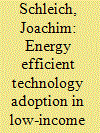

|
|
|
|
|
| Summary/Abstract |
This paper studies the adoption of high-cost, medium-cost, and low-cost energy efficient technologies (EETs) by income categories in eight European Union countries, relying on demographically representative household surveys carried out simultaneously among about 15,000 households in France, Germany, Italy, Poland, Romania, Spain, Sweden, and the United Kingdom. The statistical-econometric analyses allow the effects of income to differ by income quartiles in each country. For high cost EETs such as retrofit measures, the findings suggest that homeowners falling into the lowest income quartile exhibit lower adoption propensities than those falling into the highest income quartile. These findings provide some support for policies targeting “poor homeowners”, particularly in lower-income countries with a high share of owner-occupiers such as Poland and Romania. Further, differences in adoption propensities across income quartiles also exist for medium- and low-cost EETs such as appliances and light bulbs. Finally, analyzing factors related to homeowners receiving financial support for retrofit measures from governments or utilities suggests that differences in implementation rates between the highest and lowest income quartile would likely have been higher without such support schemes in place. For the United Kingdom (but not for other countries) these schemes appeared to have had a progressive effect.
|
|
|
|
|
|
|
|
|
|
|
|
|
|
|
|
| 6 |
ID:
175024


|
|
|
|
|
| Summary/Abstract |
Stove stacking (concurrent use of multiple stoves and/or fuels) is a poorly quantified practice in regions with ongoing efforts to transition household energy to cleaner options. Using biomass-burning stoves alongside clean stoves undermines health and environmental goals. This review synthesizes stove stacking data gathered from eleven case studies of clean cooking programs in low- and middle-income country settings. Analyzed data are from ministry and program records, research studies, and informant interviews. Thematic analysis identifiedy key drivers of stove stacking behavior in each setting. Significant (28%–100%) stacking with traditional cooking methods was observed in all cases. Reasons for traditional fuel use included: costs of clean fuel; mismatches between cooking technologies and household needs; and unreliable fuel supply. National household surveys often focus on 'primary' cookstoves and miss stove stacking data. Thus more attention should be paid to discontinuation of traditional stove use, not solely adoption of cleaner stoves/fuels. Future energy policies and programs should acknowledge the realities of stacking and incorporate strategies at the design stage to transition away from polluting stoves/fuels. Seven principles for clean cooking program design and policy are presented, focused on a shift toward "cleaner stacking" that could yield household air pollution reductions approaching WHO targets.
|
|
|
|
|
|
|
|
|
|
|
|
|
|
|
|
| 7 |
ID:
135241
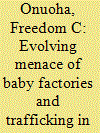

|
|
|
|
|
| Summary/Abstract |
Trafficking in persons in Nigeria has largely targeted adults and children, particularly women and girls. Of growing concern, however, is the recent emergence and growth of sophisticated and syndicated groups involved in baby ‘factories’ and trafficking in Nigeria. This article examines the nature, actors, modus operandi and motives behind this emergent dimension of human trafficking in Nigeria. It concludes that if concerted efforts are not made to deal with the actors and dismantle the market, its profitability will embolden current actors and even encourage new entrants into the booming trade – now and in the future.
|
|
|
|
|
|
|
|
|
|
|
|
|
|
|
|
| 8 |
ID:
166462


|
|
|
|
|
| Summary/Abstract |
Diffusion of low-energy houses is an important part of energy and climate policy in the European Union (EU) and in individual EU countries. Key barriers to the adoption of low-energy houses include additional construction costs and uncertainty surrounding actual energy and cost savings.
|
|
|
|
|
|
|
|
|
|
|
|
|
|
|
|
| 9 |
ID:
105729
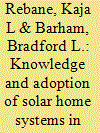

|
|
|
|
|
| Publication |
2011.
|
| Summary/Abstract |
Solar home systems (SHSs) are a promising electrification option for many households in the developing world. In most countries SHSs are at an early stage of dissemination, and thus face a hurdle common to many emerging alternative energy technologies: many people do not know enough about them to decide whether to adopt one or not. This study uses survey data collected in Nicaragua to investigate characteristics that predict the knowledge and adoption of SHSs among the rural population. First, a series of probit models is used to model the determinants of four measures of SHS knowledge. Next, a biprobit model with sample selection is employed to investigate the factors that predict SHS adoption, conditional on having sufficient knowledge to make an adoption decision. Comparison of the biprobit formulation to a standard probit model of adoption affirms its value. This study identifies multiple determinants of SHS knowledge and adoption, offers several practical recommendations to project planners, and provides an analytical framework for future work in this policy-relevant area.
|
|
|
|
|
|
|
|
|
|
|
|
|
|
|
|
| 10 |
ID:
180094


|
|
|
|
|
| Summary/Abstract |
Liquidity constraints are a key barrier to acquisition and sustained use of clean household energy in resource-poor settings. This study evaluates a pilot microfinance initiative in Kenya to help low-income rural households access liquefied petroleum gas (LPG) for cooking. Program beneficiaries received a six-month loan that covered all equipment costs and was to be repaid in monthly installments. We present results from surveys of beneficiaries (n = 69) after they began using LPG, as well as 332 non-beneficiaries from the same community (to understand how beneficiaries and non-beneficiaries differ in cooking patterns and socioeconomic outcomes). 94% of beneficiaries had repaid their loan in full and on time at the time of data collection. Meanwhile, beneficiaries were more likely than non-beneficiaries to use LPG as their primary cooking fuel (76.8% of beneficiaries versus 38.8% of non-beneficiaries). While 81.1% of beneficiaries who used LPG as their primary cooking fuel reported multiple fuel use, we find beneficiaries increased LPG use by 5.9 h per week with a corresponding decrease of 4.8 h in weekly use of biomass fuel. Our findings suggest that promoting LPG usage through microloans for equipment is likely to be both commercially viable and beneficial to health through decreased use of polluting biomass fuel.
|
|
|
|
|
|
|
|
|
|
|
|
|
|
|
|
| 11 |
ID:
169860
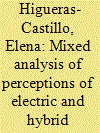

|
|
|
|
|
| Summary/Abstract |
Electric and hybrid vehicles are a prominent technology in the transport industry for mitigating air pollution. This study aims to find the key factors which mediate product adoption by assessing the main barriers to purchasing, the impact of government financial incentives and other variables such as pro-environmental behavior and social reputation. Data were collected from 404 potential consumers and analyzed through two methods. Firstly, this study approaches a structural equations model. Secondly, neural networks are examined. The obtained results reveal reliability and government financial aids as the most significant motivators. In addition, the three major variables negatively impacting perceived reliability are limited range, charging time and low infrastructure availability.
|
|
|
|
|
|
|
|
|
|
|
|
|
|
|
|
| 12 |
ID:
176658
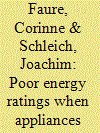

|
|
|
|
|
| Summary/Abstract |
Conveyance, i.e., leaving one's appliance in the dwelling when moving out, shortens the expected length of ownership of an appliance and may therefore lead to the purchase of less energy-efficient appliances. Employing a demographically representative survey in Spain, this paper uses statistical-econometric analyses to explore the effects of conveyance on stated adoption of energy-efficient appliances (refrigerators or fridge-freezer combinations, freezers, dishwashers, and washing machines). The findings suggest that the take-up of energy-efficient appliances is on average about 8%-points lower when appliances convey. In addition, conveyance appears to have comparable effects for renters and homeowners. These findings therefore suggest that conveyance contributes to explaining the energy efficiency paradox. Finally, the results appear robust to a series of robustness checks involving alternative assumptions about the distribution and data generating process, the specifications of the dependent variable, and the handling of missing values. They also provide insights for policy-making.
|
|
|
|
|
|
|
|
|
|
|
|
|
|
|
|
| 13 |
ID:
109633


|
|
|
|
|
| Publication |
2011.
|
| Summary/Abstract |
Many countries are endeavouring to supply more of their energy from renewable resources. Such countries are also experiencing an aging population with a greater proportion of people aged =65 years. This demographic shift may reduce the uptake of renewable energy, if older person households are less inclined to accept change and adopt new technologies. This paper assesses whether such households have different behavioural responses to energy efficiency compared to the rest of society and investigates whether micro-generation renewable energy technologies are less likely to be adopted by these households. It uses conditional logit and mixed logit models to investigate the impact of age of household on primary heating adoption, and also to assess the impact of older households on the installation of discretionary micro-generation technologies (solar thermal, solar voltaic, and wind power) to supplement existing heating and lighting systems. Results indicate that primary heating choice is not affected but that older person households are less inclined to adopt micro-generation technologies.
|
|
|
|
|
|
|
|
|
|
|
|
|
|
|
|
| 14 |
ID:
120702


|
|
|
|
|
| Publication |
2013.
|
| Summary/Abstract |
Bombay cinema endows non-sexual relationships, such as friendship and siblinghood, with a passionate intensity that equals that of sexual relationships, thus resisting a complete takeover of the emotional realm by heterosexual coupledom. Choosing sibling, friend or community over a spouse need not be seen only as retrogressive self-sacrifice; it can also be seen as choosing stronger, longer-standing relationships over newer, more flimsy ones. Films such as Naam, Bombai ka Babu and Kabhi Khushi Kabhie Gham explore the joys and costs of different types of romantic feeling, many of which are not sexual, but are just as powerful.
|
|
|
|
|
|
|
|
|
|
|
|
|
|
|
|
| 15 |
ID:
150456


|
|
|
|
|
| Summary/Abstract |
Malawi has set a target of adoption of two million improved cookstoves (ICS) by 2020. Meeting this objective requires knowledge about determinants of adoption, particularly in rural areas where the cost of traditional cooking technologies and fuels are non-monetary, and where people have limited capacity to purchase an ICS. We conducted a discrete choice experiment with 383 households in rural Malawi asking them if they would chose a locally made ICS or a package of sugar and salt of roughly equal value. Six months later, we assessed adoption and stove use patterns. Sixty-six percent of households chose the ICS. We find that having a larger share of crop residues in household fuel supply, awareness of the environmental impacts of woodfuel reliance, time the primary cook devotes to collecting fuelwood, and peer effects at the village-level increase the odds of choosing the ICS. Having a large labor supply for fuelwood collection and experience with a non-traditional cooking technology decreased the odds of choosing the ICS. In a rapid assessment six months after stoves were distributed, we found 80% of households were still using the ICS, but not exclusively. Our findings suggest considerable potential for wide-scale adoption of low cost ICS in Malawi.
|
|
|
|
|
|
|
|
|
|
|
|
|
|
|
|
|
|
|
|
|